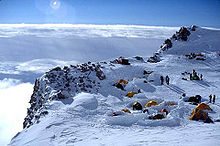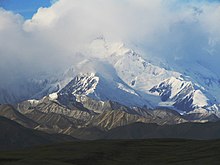Denali
Denali (/dəˈnɑːli/),[5][6] officially known as Mount McKinley,[7] is the highest mountain peak in North America, with a summit elevation of 20,310 feet (6,190 m) above sea level.In August 2015, 40 years after Alaska had done so, the United States Department of the Interior announced the change of the official name of the mountain to Denali.[35] The renaming of the mountain received praise from Alaska's senior U.S. senator, Republican Lisa Murkowski,[36] who had previously introduced legislation to accomplish the name change,[37] but it drew criticism from several politicians from President McKinley's home state of Ohio, such as Governor John Kasich, U.S.Senator Rob Portman, U.S. House Speaker John Boehner, and Representative Bob Gibbs, who described Obama's action as "constitutional overreach" because he said an act of Congress was required to rename the mountain.Trump had previously proposed changing the name in 2017, drawing opposition from Alaska's Republican governor Mike Dunleavy.[13][14] The same day, the Associated Press announced that it would use Mount McKinley instead of Denali, with the reasoning that as president, Trump has the authority to change federal geographical names of features lying within national borders.[4] A British naval captain and explorer, George Vancouver, is the first European on record to have sighted Denali, when he noted "distant stupendous mountains" while surveying the Knik Arm of the Cook Inlet on May 6, 1794.[51] William Dickey, a New Hampshire-born resident of Seattle, Washington who had been digging for gold in the sands of the Susitna River, wrote, after his returning from Alaska, an account in the New York Sun that appeared on January 24, 1897.The party landed at Cook Inlet in late May, then traveled east, paralleling the Alaska Range, before reaching the slopes of Denali in early August.[56] After the party's return, Brooks co-authored a "Plan For Climbing Mt McKinley", published in National Geographic magazine in January 1903, with fellow party-member and topographer D. L. Raeburn, in which they suggested that future attempts at the summit should approach from the north, not the south.[58] During the early summer of 1903, Judge James Wickersham, then of Eagle, Alaska, made the first recorded attempt to climb Denali, along with a party of four others.The group attempted to get as close to the mountain as possible via the Kantishna river by steamer, before offloading and following Chitsia Creek with a poling boat, mules and backpacks, a route suggested to them by Tanana Athabaskan people they met along the way.The party received further navigational assistance at Anotoktilon, an Athabaskan hunting camp, where residents gave the group detailed directions to reach the glaciers at the foot of Denali.[63] Although Cook's 1903 expedition did not reach the summit, he received acclaim for the accomplishment, a 1,000 miles (1,609 km) trek in which he not only circled the entire mountain but also found, on the descent, an accessible pass northeast of the Muldrow Glacier following the headwaters of the Toklat and Chulitna rivers.[59] In 1906, Cook initiated another expedition to Denali with co-leader Herschel Parker, a Columbia University professor of electrical engineering with extensive mountaineering experience.Cook and Parker's group spent most of the summer season exploring the southern and southeastern approaches to the mountain, eventually reaching a high point on Tokositna glacier, 25 miles (40 km) from the summit.Browne later wrote that he knew Cook's claims were lies, just as "any New Yorker would know that no man could walk from the Brooklyn Bridge to Grant's Tomb [a distance of eight miles] in ten minutes.[65] In 1998, historian Robert Bryce discovered an original and un-cropped version of the "fake peak" photograph of Barrill standing on the promontory.Jon Waterman, author of the book Chasing Denali, which explored the controversy, outlined several reasons to doubt the claim: There was never any photographic evidence."[70] He noted that the men were largely unlettered and that some of the ensuing doubt was related to their lack of sophistication in dealing with the press and the contemporary climbing establishment.[71][72][73] The first ascent of the main summit of Denali came on June 7, 1913, by a party directed by Hudson Stuck and Harry Karstens, along with Walter Harper and Robert Tatum.Karstens relocated to Alaska in the gold rush of 1897, and in subsequent years became involved in a variety of endeavors beyond mining, including helping establish dog mushing routes to deliver mail across vast swathes of territory and supporting expeditions led by naturalist Charles Sheldon near the base of Denali.[75] At 21 years old, Harper was already known as a skilled and strong outdoorsman, the Alaska-born son of a Koyukon-Athabascan mother and Irish gold prospector father.While ferrying loads up to a camp at around 10,800 feet (3,292 m), they suffered a setback when a stray match accidentally set fire to some supplies, including several tents.On May 30, the team, with the help of some good weather, ascended to a new high camp, situated at 17,500 feet (5,334 m) in the Grand Basin between the north and south peaks.Stuck and Karstens' team achieved the uncontroversial first ascent of Denali's south peak; however, the news was met with muted interest by the wider climbing community.[81] The vast majority of climbers use the West Buttress Route, pioneered in 1951 by Bradford Washburn,[15] after an extensive aerial photographic analysis of the mountain.On the previous day of November 30, 2003, a temperature of −74.4 °F (−59.1 °C) combined with a wind speed of 18.4 miles per hour (29.6 km/h) to produce a North American record windchill of −118.1 °F (−83.4 °C).According to the National Park Service, in 1932 the Liek-Lindley expedition recovered a self-recording minimum thermometer left near Browne's Tower, at about 15,000 feet (4,600 m), on Denali by the Stuck-Karstens party in 1913.







Denali (disambiguation)Wonder LakeElevationProminenceAconcaguaIsolationListingWorld's most prominent peaksWorld's most isolated peaksSeven SummitsCountry high pointsNorth America highest peaksUS highest major peaksAlaska highest major peaksU.S. state high pointsCoordinatesDenali National Park and PreserveAlaskaParent rangeAlaska RangeTopo mapFirst ascentHudson StuckHarry KarstensWalter HarperRobert TatumEasiest routemountainNorth Americasea leveltallest mountain in the world from base-to-peaktopographic prominencetopographic isolationthird most prominentthird-most isolatedMount EverestU.S. stateKoyukon peopleWilliam McKinleyfederal government of the United StatesUnited States Department of the Interiorofficial name of the mountainDonald TrumpSecretary of the InteriorDepartment of the InteriorJames WickershamFrederick CookBradford WashburnU.S. Geological Surveyphotogrammetrygraniticplutonquartz monzonitetectonicsubductionPacific PlateNorth American PlatesedimentaryerosionearthquakesAleutian IslandsDenali FaultYakutat microplateTibetan PlateauMauna KeafourteenermassifPeters GlacierMuldrow GlacierTraleika GlacierRuth GlacierKahiltna GlacierDenali–Mount McKinley naming disputeKoyukonAthabaskansRussian ownership of AlaskaRussianWoodrow WilsonLyndon B. JohnsonWinston ChurchillUnited States Board on Geographic NamesRalph RegulaCantonBarack Obama administrationU.S. Secretary of the InteriorSally JewellLisa MurkowskiGovernorJohn KasichU.S. SenatorRob PortmanU.S. House SpeakerJohn BoehnerRepresentativeBob GibbsCongressAlaska Dispatch NewsPresident-electsecond termRepublicanMike DunleavyDan SullivanScott KawasakiDemocratsecond inaugurationexecutive orderDenali National ParkAssociated PressDena'inaLower TananaUpper KuskokwimHolikachukDeg XinagTanana Chiefs ConferenceAlaskan AthabascanUpper Inlet Dena'inaLower Inlet Dena'inaTananaKuskokwimGeorge VancouverEuropeanKnik ArmCook InletLavrenty ZagoskinNew HampshireSeattle